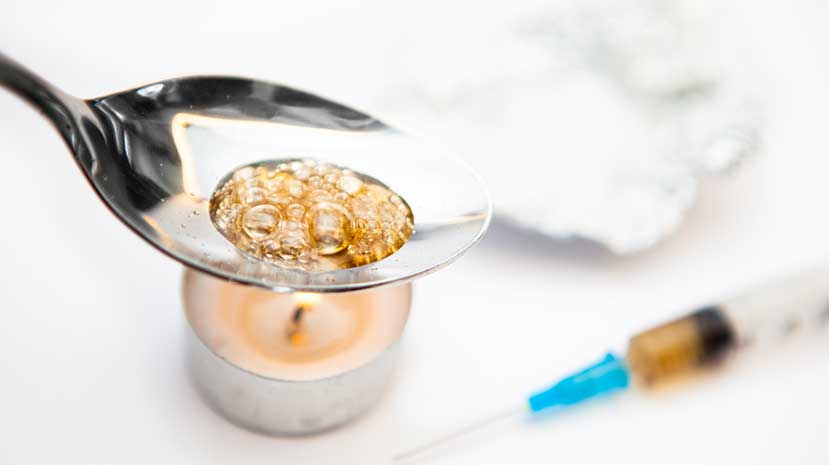Heroin Addiction | Heroin In Ohio

Medically Reviewed By: Kimberly Langdon, M.D.
Heroin is a Schedule I controlled substance, meaning that it is a dangerous and addictive drug that is not considered to have a valid medical use in the United States.

Heroin is a powerful, illicit opiate narcotic produced from opium poppy plants. It is twice as potent as its originator drug, morphine, and may resemble a fine white powder or a sticky black tar.
In recent years, heroin has contributed heavily to the American opioid epidemic, though it is being increasingly overtaken by the far more potent synthetic opioid drug fentanyl.
Heroin Facts
Diamorphine was first synthesized in 1874 by a chemist in London, and again in 1897 by another chemist working for Bayer pharmaceutical company in Germany.
Dubbed heroin, a name taken from the German word heroisch (equivalent to the English term heroic) the new painkiller was internationally exported and proved especially popular in the United States.
It was then outlawed in the US in 1924 due to its high potential for drug addiction, overdose, and other chronic health problems.
Controlled Drug Status
Heroin is now classified as a Schedule I controlled substance, meaning that it is a dangerous and addictive drug that is not considered to have a valid medical use in the United States.
Using, possessing, selling, or transporting heroin is considered a felony, and anyone who is convicted of supplying the heroin that leads to an overdose faces especially severe penalties.
Production & Distribution
Most heroin is produced from opium poppies and morphine in Afghanistan, with smaller amounts produced in Southeast Asia, Mexico, and Columbia. It is then smuggled across international borders, diluted with filler compounds, and sold on the black market.
Heroin Abuse In Ohio
Heroin can be used in a variety of ways, including:
- injection – the most common method for heroin abuse, and for black tar heroin use, in particular, injection or shooting delivers the drug directly into the bloodstream through a syringe
- smoking – smoking involves heating the drug, usually white powder heroin, on tinfoil or another metal surface and inhaling the vapors, which then pass the drug into the bloodstream through the lungs
- snorting – white powder heroin can also be inhaled through the nostrils, allowing the drug to be absorbed through the delicate mucous membranes of the sinus cavity
Effects Of Heroin Addiction
Some try heroin after becoming addicted to prescription drugs first. Others are exposed to heroin in their environment, sometimes trying heroin mixed with cocaine or methamphetamine to form an often-lethal drug cocktail known as a speedball.
When used, heroin rapidly binds to opioid receptors in the brain and elsewhere in the body, triggering an intense and euphoric release of dopamine, far beyond what a person can experience normally.
This intensity of pleasure triggers the brain’s reward system and changes how it works, setting up a compulsive desire to seek out heroin in the future and to feel that pleasure again and again.
Heroin abuse then develops into physical dependence followed by addictive fixation, cravings, behavioral changes, and devastating short or long-term health effects.
Heroin Overdose
Unpredictable street drugs like heroin are responsible for tens of thousands of overdose deaths each year, and addiction only increases a person’s risk of dying or suffering other severe harms.
Heroin and other opioids can cause death by slowing or stopping a person’s bodily functions, especially their breathing.
Key signs of a heroin/opioid overdose may include:
- gasping for air
- shallow breathing
- pale skin
- blue-tinted lips or fingertips
- low body temperature
- pinpoint pupils
- weak or unsteady pulse
- disorientation or confusion
- spasms or seizures
- nausea or vomiting
- inability to stay awake
- coma or unresponsiveness
If you suspect a heroin overdose has occurred, immediately administer the opioid antidote drug naloxone (Narcan) if available, call your local emergency medical services, and administer first aid and CPR until they arrive.
Signs Of Heroin Addiction
Abusing heroin can cause a wide range of predictable changes to a loved one’s behavior, personal priorities, and mental health. Common signs of heroin addiction include:
- loss of passion and joy
- withdrawal from personal relationships
- secretive or deceptive behavior
- drug-seeking behavior and theft
- shirking responsibilities at home, in class, or in the workplace
- financial strain
- neglected hygiene, diet, exercise, and self-care
- defensiveness and emotional instability
- frequent unexplained illness or absences
- physical signs of drug use (track marks and scars, infections, nosebleeds, etc.)
Heroin Addiction Treatment Programs In Ohio
Substance use disorders are not easy to overcome alone. Fortunately, a variety of treatment options have been developed to help those struggling with heroin use and addiction.
Personalized heroin addiction treatment plans may include:
Medical Detoxification
Detox programs help participants through heroin withdrawal symptoms while offering close medical supervision, support, and care
Inpatient/Residential Treatment
Inpatient treatment provides those in recovery with a safe, secure environment for recovery. Stays can last 30-60 days or more and involve extended in-depth behavioral health interventions.
Behavioral Therapies
Behavioral therapies, including cognitive-behavioral therapy (CBT) and motivational enhancement therapy (MET), focus on changing the way participants think and feel about their drug abuse and other choices, so they can make positive and lasting changes.
Medication-Assisted Treatment (MAT)
MAT programs use FDA-approved medications which have been shown to help those in recovery in different ways:
- buprenorphine – often paired with naloxone, buprenorphine is a partial opioid agonist that binds to opioid receptors to reduce cravings and withdrawal symptoms, blunting the effects of other opioid drugs
- methadone – a mild, long-acting opioid drug that relieves cravings and withdrawal symptoms and blunts the effects of other opioid drugs
- naltrexone – an opioid antagonist that blocks opioid receptors, preventing opioid use from having any euphoric effects while naltrexone is active in the body
Aftercare Support
Addiction recovery is a lifelong process. Those who participate in rehabilitation should receive long-term support through case management, employment assistance, peer support groups, alumni groups, and other supportive programs.
If you would like to learn more about your options for heroin recovery treatment programs, including medical detox, inpatient care, and medication-assisted treatment, please contact Ohio Recovery Center today.
FAQ
How Long Does Heroin Stay In Your System?
Detection of heroin use has long been a priority in different types of drug screenings, and stays in your system for up to 3 days after last use.
Learn more about How Long Heroin Stays In Your System
How Much Does Heroin Cost?
Heroin costs $5 to $20 per bag, which typically contains one-tenth to one-twentieth of a gram of heroin (several doses).
The street price of heroin can be affected by several factors, including:
- supply and demand
- type of heroin
- purity
- quantity
Learn more about Heroin Street Prices
What Is Heroin Cut With?
Highly pure heroin is extremely uncommon in the United States. Typically, the drug will be cut with a variety of different substances like sugars, quinine, cornstarch, powdered milk, fentanyl, local anesthetics, and others, which can increase the drug’s bulk or change its effects.
Learn more about Heroin Cutting Agents & Adulterants
What Do The Different Types Of Heroin Look Like?
The different types of heroin can be white, black, or brown, and can come as a powder or as a stickier tar-like substance.
Learn more about What Heroin Looks Like
What Does Heroin Smell Like?
Although pure heroin is likely odorless, heroin can smell like the ingredients added to it, such as sugar, starch, or quinine. It may also smell vinegar-like, sweet, or acidic, and many identify the smell of heroin with burnt plastic.
Learn more about What Heroin Smells Like
How Does Plugging Heroin Work?
When plugged, heroin is usually dissolved or mixed into water and administered using a syringe without a needle. The drug is then rapidly absorbed into the bloodstream through the delicate membranes of the rectum.
Learn more about Plugging Heroin
What Is Heroin Called On The Street?
Heroin may be called China white, dog food, smack, dope, and many other slang names in Ohio. These names may vary depending on the form of heroin sold.
Learn more about Heroin Street Names
- Encyclopedia Britannica - heroin | Definition, Effects, Abuse, & Facts https://www.britannica.com/science/heroin
- National Institute on Drug Abuse (NIDA) - Heroin DrugFacts https://nida.nih.gov/publications/drugfacts/heroin
- National Institute on Drug Abuse (NIDA) - Heroin Research Report: Overview https://nida.nih.gov/publications/research-reports/heroin/overview
- Substance Abuse and Mental Health Services Administration (SAMHSA) - Medication-Assisted Treatment (MAT) https://www.samhsa.gov/medication-assisted-treatment
- Substance Abuse and Mental Health Services Administration (SAMHSA) - SAMHSA Opioid Overdose Toolkit https://store.samhsa.gov/sites/default/files/d7/priv/sma18-4742.pdf

